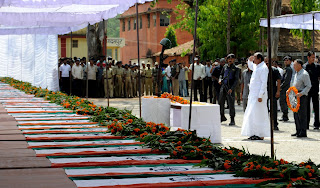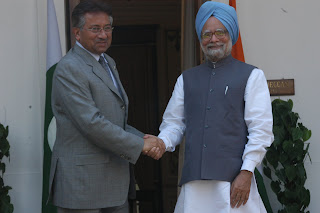Primary among these are from the liberal or “socialistic” wing of the party who want the rising monetary resources of the government to be used in ever-greater quantities for social welfare programmes. In the process, not only do they insist on putting fiscal stress on the country’s financial system, but also, and more importantly, ensuring that the country cannot exploit the tiny window of opportunity that has opened up to get on to the track of double-digit economic growth.
So we have the spectacle of tens of thousands of crore rupees being shoveled into programmes that neither create assets to transform the countryside, let alone ever reach the people it is intended for.
Poverty
The issue is not that we should not feed the starving or provide succour to the needy, but of the need to evolve processes which will transform them into productive and fulfilled members of society. India’s socialistic bleeding heart policies seem aimed at keeping people permanently dependent on the hand-out mode.
Last week in a move to shovel some more money, the number of poor in India formally went up by 100 million. The Planning Commission issued a fiat that declared that 37.2 per cent of Indians were below the poverty line, not 27 per cent. Every country has a BPL line, even the rich Americans and Europeans, and there is an arbitrariness in the process of defining who is poor in a particular society. But in the case of India, the whole process is a hit and miss affair.

As an article by V.K. Ramachandran et al in Tuesday’s The Hindu pointed out, the official BPL figures are probably not worth the paper they are written on. The sad truth is that while all the Jawaharlal or Rajiv yojanas look grand on paper, there are serious question marks about their efficacy. Grand legislation of the Bismarckian variety promising universal education, the right to work and food is good politics, but poor policy. The tawdry reality sinks in when you stir out of New Delhi and find the money for the schemes going into an endless sink of corruption.
Earlier this week, the authorities caught three senior income tax officers taking bribes. Sadly, they are the norm rather than the exception and their fault happens to be that they were caught. Anecdotal evidence suggests that corruption has now become all pervasive and leaves nothing untouched from mega-projects to the office stationery. Most social welfare schemes are prone to the crassest kind of corruption because they steal from the poor and the needy.
It is true that it is easier to point to the faults than to provide a remedy. The fix cannot be found in technology options such as e-governance or coupons. In the Indian context, even they will be corrupted. It lies in liberating the people from the feudal patronage system of the government. Through history the feudal system worked in such a way that down the line each feudatory kept what he wanted for himself as part of the largesse; the people fended for themselves.
No one will argue that malnutrition, hunger, human rights abuses do not exist, and that the Indian state should not make any effort to ameliorate them. Leave alone the moral imperative, the state should act from the pragmatic impulse which understands that only better fed, healthy and educated citizens can become productive members of
society.
However, the issue is the balance that must be struck at any given point in time between what can be spent on a social safety net, and what is needed to ensure a productive and growing economy which enables people to look after themselves. There has to be an effort to understand that we cannot live on a diet of populism alone, that there must be a concept of short-term sacrifice for long-term gain.
Gujarat
Take the challenge of stagnant agriculture that we are confronting today. We need deep reform involving water management, electricity pricing, market mechanisms, and so on to make our agriculture productive. Just what can be done, too, is staring us in the face. The Gujarat state has had a growth rate averaging 9.6 per cent in the past decade because it has acted in these areas according to a paper in the Economic and Political Weekly written by Tushaar Shah, Ashok Gulati et al in December 2009. Remarkably the paper points out that the major locus of growth was the arid Saurashtra, Kutch and north Gujarat, and not the command area of the Narmada dam. According to the authors, the BJP government “has actually devoted a great deal of energy and resources to accelerating agricultural growth through a broad spectrum of policy initiatives.” These include 1) creating more than 1 lakh water bodies allowing groundwater to be recharged and therefore allowing 2) multiple cropping and higher value agriculture; (3) market access; (4) road and other infrastructure. “Gujarat is the only state whose groundwater balance has turned positive in recent years,” state the authors. There are, of course, specificities that have been responsible for the Gujarat success story such as the use of Bt cotton and generally good rainfall, but a key cause was better water management. State chief minister Narendra Modi may be rightly reviled for the 2002 massacre of Muslims, but this is no reason why the lessons from the Gujarat agricultural “miracle” cannot be applied elsewhere.
Reform
Prime Minister Manmohan Singh is someone who understands the issues well and knows what must be done. There is a limited window that the country has to remain on the path of sustained high economic growth. To provide immediate relief to the poor and to permanently change their situation through better healthcare, education, skills and quality jobs, you need a booming economy which has its own and urgent need for resources.
But the party seems unclear about the path it must take. Bleeding heart populism has been a part of its DNA. But there is only so much that throwing money at a problem, or raising slogans and creating statutes, can achieve.
The country needs much more extensive reform of its governing structures for solutions to problems which are structural and chronic. A corrupt and inept bureaucracy cannot deliver anything and prevent everything from happening. The solutions lie at the very fountainhead of the system— in the conduct of politics and governance of the country.
This is the challenge the Congress confronts. But as of now it seems to be more taken up with the shenanigans of the IPL rather than the slew of weightier issues that are there.
This article appeared in Mail Today April 22, 2010







